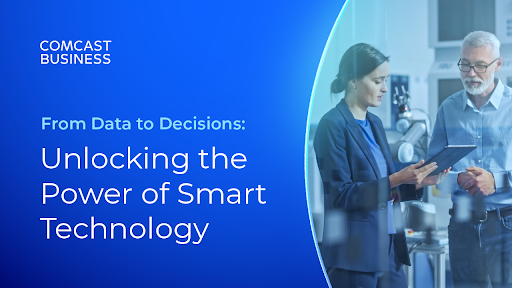Big Data, Big Results

The retail industry is undergoing a sea of change, thanks in large part to technology. Advances in data collection and analysis have given retailers today incredible insight into the shopping habits and experiences of their customers.
Big data is furthering that insight for retailers, providing the ability to push beyond simply tracking a shopper’s purchases to provide experiences that are proactive rather than reactive. Through data collected from multiple sources including in-store and online purchases, payment information and even comments on social media, retailers now have the ability to meet the unique needs of each of their customers—sometimes before they know they even have a need.
Creating that proactive shopping experience means retailers must rely on their technology to collect and analyze data to create actionable insights. They must ensure their network is powerful enough to support an infrastructure designed to power big data and the accompanying customer-facing applications that provide unique and personal shopping experiences.
Big Data – A Brief Introduction
The term “big data” describes the massive amounts of data that inundates companies on a daily basis, from internal and external sources. Business transactions, social media and information from sensor or machine-to-machine data all contribute to the influx of data that threatens to overwhelm organizations.
Big data is described by three components: volume, velocity and variety:
Volume refers to the amount of data collected
Velocity refers to the rate at which data flows into an organization
Variety refers to the myriad types—and diversity—of data able to be collected
Combined, these components present a powerful tool for companies to transform the way they do business. Smart companies understand this power and are finding ways to incorporate big data analytics into their decision-making to drive faster, more accurate results.
Say, for example, a retailer offers two styles of a particular model of coat, one featuring a zipper and the other featuring buttons. The retailer may notice more customers are favoring and purchasing styles that feature buttons. Shoppers, meanwhile, are posting comments online about how much they like the style of coat with the buttons, but it is always out of stock.
Big data has the power to provide the retailer with information from its internal (structured) systems for its entire outwear inventory to see which models are selling, at what price points the coats are selling fastest, and which coats are being returned by customers and why. Using big data, the retailer also can glean information from external (unstructured) sources to determine which of its competitors are selling the coats and at what price points, as well as what customers are saying online about the coats. From there, the retailer can make informed decisions on whether to increase or decrease the price of its button-style coats, increase its inventory of button-style coats to meet customer demand, and decrease its inventory of zipper-style coats—or ship them to regions where zipper-style coats are more popular.
Such insights also could help the retailer in its upsell or cross-sell opportunities online, suggesting options to shoppers such as similar-style coats that have buttons or complimentary garments such as scarves, boots, hats or gloves.
Indeed, the business benefits of big data are many. In short, big data can provide a wealth of information to help companies make better business decisions to streamline operations, reduce waste, delight customers and improve their bottom line.
Big Data in Retail
The impact big data can have on the retail space is profound. Considering the example given above, it’s easy to see how retailers can better manage their costs and improve their bottom line. In fact, according to The Data Science Institute, companies that are the top performers use big data and predictive analytics five times more than lower performers.
Bernard Marr, writing in Forbes, spells out the degree to which big data can help retailers:
“Big data analytics is now being applied at every stage of the retail process – working out what the popular products will be by predicting trends, forecasting where the demand will be for those products, optimizing pricing for a competitive edge, identifying the customers likely to be interested in them and working out the best way to approach them, taking their money and finally working out what to sell them next.”
Big data can be useful to retailers in so many other ways beyond improving their bottom line. Perhaps most important is retailers’ ability to use big data to create exceptional customer experiences. In today’s retail environment, the always-connected consumers have no qualms about switching retailers or service providers if they are dissatisfied. In fact, half of consumers taking part in one study said they would take their business to another brand within a day of having a poor customer experience, and 80 percent would take their business to another brand within a week. What’s more, a Dimensional Research/ZenDesk survey revealed that 48 percent of customers who have had a negative experience would recommend that others not buy products or services from a particular company.
That’s where big data can help. Big data can act as the “eyes and ears” of a retailer to discover customer sentiment. By collecting and analyzing both structured and unstructured data from its website and external sources such as social media sites, the retailer can gain insight to whether customers are satisfied or unsatisfied, and the cause of their feelings.
Big data can even help retailers target consumers who are likely customers for a new or upcoming product or service. Using data transaction records, data from loyalty programs and other information, retailers can pinpoint which of their customers most likely will purchase their latest offering—and even how many. Such forecasting information is useful for inventory control and ensuring retailers will be able to meet customer demand. It also helps improve customer service, by providing customer service centers with useful information about particular customers—especially the most loyal ones—to deliver even higher levels of service.
Perhaps big data’s greatest impact—or, at least, the one most discernable by customers—is its power to create personalized shopping experiences. Using information collected from previous transactions, social media sites, clickstreams (online shopping habits such as cart abandonment, etc.) and even a customer’s location from GPS, a retailer could send out highly targeted advertising, including coupons and other promotions, directly to customers’ smartphones when they are near or in the store. Knowing what a customer has purchased in the past can enable a retailer to offer more meaningful promotions, such as a discount on surround sound system based on the customer’s previous purchase of a big-screen television.
Case Studies – Big Data in Retail
Successful retailers have been relying on the insight provided by big data analytics to discover new customers, better engage with current customers and uncover patterns associated with former customers. Here are a few examples of big data in the retail environment to better illustrate its power.
An Ounce of Prevention: Drug store retailer Walgreens is using the power of big data to treat patients at its walk-in clinics and spot unfulfilled prescriptions, which could impact a patient’s health if the medication isn’t taken and lead to more health problems (and, hence, more prescriptions) down the road. Such a move helps keep customers’ healthcare regimens and helps reduce the possibility of the need for more—and possibly more expensive—medication.
Walgreens is using the data of 7.5 billion medical events for 100 million people that includes demographics, enrollment, diagnoses, procedures and data from managed-care plans.
The retailer is also using the information to deliver a more holistic healthcare experience—for example, identifying when a patient is overdue for a routine checkup or screening. The system alerts of any gaps, enabling the clinician to make recommendations to the patient during the clinic visit.
Getting Smart with Social: Office supply retailer Staples is using big data to better engage with customers and understand their likes and dislikes to improve the buying experience. The company is analyzing social media channels such as Twitter, Facebook, LinkedIn and others to collect relevant unstructured data, which serves to help Staples increase customer communication and give the customers a “louder” voice in daily operations, as well as helping to improve its corporate agility and inventory of offerings.
With the results gleaned from its big data social media efforts, Staples could discern more quickly whether its media campaigns were working, enabling it to reduce spending on ineffective marketing. What’s more, the company is able to see whether customers are able to find products and information easily on the website, and discern which store policies and processes are working and which ones aren’t.
Better Customer Targeting: Luxury and sports eyewear maker Luxottica collects customer information from its websites and retail stores to create targeted marketing and promotions to its base of 110 million customers worldwide. The individualized marketing provides more value and is a more effective vehicle than mass promotions.
The information garnered from Luxottica’s efforts also helped the company identify which customers were omni-channel—those who shopped both online and in-store—and create marketing campaigns directly for this channel of customers, who typically spend more than online-only or store-only customers.
The Network is the Key
Each case study shows the impact of big data on delivering the information necessary to provide a top-notch customer experience. At the heart of these and other big data initiatives is a network that can support the infrastructure necessary for such big data initiatives.
Using big data to mine actionable customer insight will be the source of competitive advantage for the modern retailer. Big data initiatives demand storage and bandwidth to process all of this data, and retailers will need to get a handle on the sheer volume, velocity and variety of the data needed.
Indeed, big data requires a network powerful enough to handle the deluge of data from multiple sources and deliver that data to resources that can process that data effectively. Ideally, a network should include dedicated, broadband and WiFi service to ensure an always-on, always-available connection to collect big data, deliver it to the cloud, analyze the data and turn the information into actionable insights.
What’s more, retailers with multiple locations, such as retail stores, should have a network that can work effectively no matter where users are located. This distributed enterprise model can benefit greatly from cloud services, which can collect, analyze and store customer data and provide a single point of contact for each location, from headquarters to call centers to retail stores. As a result, all locations have access to the same customer information to deliver a consistent experience without having to manage their own internal data centers.
A WiFi network, meanwhile, can deliver much more than connectivity to customers. In-store WiFi can enable a retailer to interact personally with customers at or near the store’s location and provide incentives such as coupons or free offers to encourage spending. Those offers can be personalized further based on the customer’s past shopping experiences—information garnered from big data analytics, which can collect the shopping habits of any customer connecting to the network.
Big data and the accompanying customer-facing applications provide unique and personal shopping experiences that can help retailers differentiate themselves from their competitors. It’s critical, then, that retailers have a network that can support big data analytics solutions and act on the insights gained.
Conclusion
Big data can provide retailers with incredible insight into their customers’ shopping habits and experiences to deliver personalized, top-notch customer service. Their networks, therefore, must be powerful enough to support an infrastructure designed to power big data and the accompanying customer-facing applications that provide those unique and personal shopping experiences.
Big data can provide retailers with incredible insight into their customers’ shopping habits and experiences to deliver personalized, top-notch customer service.
Locked Content
Click on the button below to get access
Unlock NowOr sign in to access all content on Comcast Business Community
Resource Center
Learn how Comcast Business can help
keep you ready for what's next.











